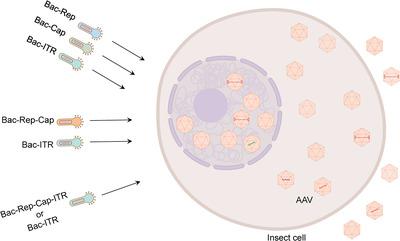当前位置:
X-MOL 学术
›
Biotechnol. J.
›
论文详情
Our official English website, www.x-mol.net, welcomes your
feedback! (Note: you will need to create a separate account there.)
Advancements in molecular design and bioprocessing of recombinant adeno‐associated virus gene delivery vectors using the insect‐cell baculovirus expression platform
Biotechnology Journal ( IF 3.2 ) Pub Date : 2020-12-04 , DOI: 10.1002/biot.202000021 Pranav R.H. Joshi 1 , Alina Venereo‐Sanchez 1 , Parminder S. Chahal 2 , Amine A. Kamen 1
Biotechnology Journal ( IF 3.2 ) Pub Date : 2020-12-04 , DOI: 10.1002/biot.202000021 Pranav R.H. Joshi 1 , Alina Venereo‐Sanchez 1 , Parminder S. Chahal 2 , Amine A. Kamen 1
Affiliation

|
Despite rapid progress in the field, scalable high‐yield production of adeno‐associated virus (AAV) is still one of the critical bottlenecks the manufacturing sector is facing. The insect cell‐baculovirus expression vector system (IC‐BEVS) has emerged as a mainstream platform for the scalable production of recombinant proteins with clinically approved products for human use. In this review, we provide a detailed overview of the advancements in IC‐BEVS for rAAV production. Since the first report of baculovirus‐induced production of rAAV vector in insect cells in 2002, this platform has undergone significant improvements, including enhanced stability of Bac‐vector expression and a reduced number of baculovirus‐coinfections. The latter streamlining strategy led to the eventual development of the Two‐Bac, One‐Bac, and Mono‐Bac systems. The one baculovirus system consisting of an inducible packaging insect cell line was further improved to enhance the AAV vector quality and potency. In parallel, the implementation of advanced manufacturing approaches and control of critical processing parameters have demonstrated promising results with process validation in large‐scale bioreactor runs. Moreover, optimization of the molecular design of vectors to enable higher cell‐specific yields of functional AAV particles combined with bioprocess intensification strategies may also contribute to addressing current and future manufacturing challenges.
中文翻译:

昆虫细胞杆状病毒表达平台在重组腺相关病毒基因传递载体的分子设计和生物加工方面的进展
尽管在该领域取得了长足的进步,但可扩展的高产量腺伴随病毒(AAV)仍然是制造业面临的关键瓶颈之一。昆虫细胞杆状病毒表达载体系统(IC‐BEVS)已成为可扩展生产重组蛋白的主流平台,并具有临床认可的供人类使用的产品。在这篇评论中,我们详细介绍了用于rAAV生产的IC-BEVS的进步。自2002年首次报道杆状病毒诱导在昆虫细胞中产生rAAV载体以来,该平台已进行了重大改进,包括增强了Bac-vector表达的稳定性和减少了杆状病毒共感染数量。后一种精简策略导致最终开发了Two-Bac,One-Bac和Mono-Bac系统。进一步改进了由可诱导包装昆虫细胞系组成的杆状病毒系统,以增强AAV载体的质量和效力。同时,先进的制造方法的实施和关键工艺参数的控制已在大规模生物反应器运行中进行了工艺验证,显示出令人鼓舞的结果。此外,优化载体的分子设计以实现功能性AAV颗粒更高的细胞特异性产量,再结合生物过程强化策略,也可能有助于解决当前和未来的制造挑战。先进制造方法的实施和关键工艺参数的控制已在大规模生物反应器运行中进行了工艺验证,显示出令人鼓舞的结果。此外,优化载体的分子设计以实现功能性AAV颗粒更高的细胞特异性产量,再结合生物过程强化策略,也可能有助于解决当前和未来的制造挑战。先进制造方法的实施和关键工艺参数的控制已在大规模生物反应器运行中进行了工艺验证,显示出令人鼓舞的结果。此外,优化载体的分子设计以实现功能性AAV颗粒更高的细胞特异性产量,再结合生物过程强化策略,也可能有助于解决当前和未来的制造挑战。
更新日期:2020-12-04
中文翻译:

昆虫细胞杆状病毒表达平台在重组腺相关病毒基因传递载体的分子设计和生物加工方面的进展
尽管在该领域取得了长足的进步,但可扩展的高产量腺伴随病毒(AAV)仍然是制造业面临的关键瓶颈之一。昆虫细胞杆状病毒表达载体系统(IC‐BEVS)已成为可扩展生产重组蛋白的主流平台,并具有临床认可的供人类使用的产品。在这篇评论中,我们详细介绍了用于rAAV生产的IC-BEVS的进步。自2002年首次报道杆状病毒诱导在昆虫细胞中产生rAAV载体以来,该平台已进行了重大改进,包括增强了Bac-vector表达的稳定性和减少了杆状病毒共感染数量。后一种精简策略导致最终开发了Two-Bac,One-Bac和Mono-Bac系统。进一步改进了由可诱导包装昆虫细胞系组成的杆状病毒系统,以增强AAV载体的质量和效力。同时,先进的制造方法的实施和关键工艺参数的控制已在大规模生物反应器运行中进行了工艺验证,显示出令人鼓舞的结果。此外,优化载体的分子设计以实现功能性AAV颗粒更高的细胞特异性产量,再结合生物过程强化策略,也可能有助于解决当前和未来的制造挑战。先进制造方法的实施和关键工艺参数的控制已在大规模生物反应器运行中进行了工艺验证,显示出令人鼓舞的结果。此外,优化载体的分子设计以实现功能性AAV颗粒更高的细胞特异性产量,再结合生物过程强化策略,也可能有助于解决当前和未来的制造挑战。先进制造方法的实施和关键工艺参数的控制已在大规模生物反应器运行中进行了工艺验证,显示出令人鼓舞的结果。此外,优化载体的分子设计以实现功能性AAV颗粒更高的细胞特异性产量,再结合生物过程强化策略,也可能有助于解决当前和未来的制造挑战。











































 京公网安备 11010802027423号
京公网安备 11010802027423号